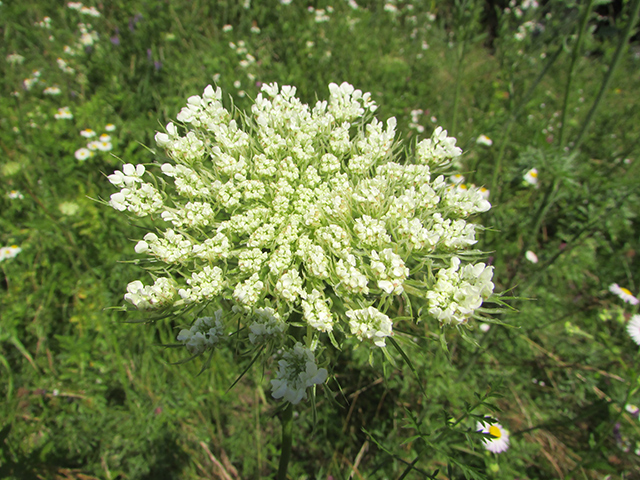 |
| Queen Anne's Lace, scientifically known as Daucus carota, is a captivating wildflower that flourishes during the summer months. It shares its family with the familiar garden carrot, boasting a root that also emits a pleasant carrot-like fragrance when crushed. Interestingly, rubbing the leaves of Queen Anne's Lace produces an unexpected aroma akin to that of parsley. |
Fascinating Facts about Queen Anne's Lace
Queen Anne's Lace is renowned for its beautiful white, lace-like flowers that form flat umbels in their early stages. These flowers are supported by green, hairy stems that gracefully curve, creating a captivating bird's nest appearance as they mature. During this phase, the plant starts bearing fruits.
The name "Queen Anne's Lace" traces its origins to Queen Anne of England, King James I's wife. Legend has it that while she was crafting lace, she accidentally pricked her finger, and a drop of blood fell onto the lace. The center of Queen Anne's Lace flower, resembling the dark purple spot on the lace, earned it the name "Queen Anne's Lace."
Beyond its ornamental value, Queen Anne's Lace is a highly versatile and edible plant, often foraged in the wild. Its taproot bears a striking resemblance to a carrot and can be consumed when young. Although some may find it fibrous even after extended boiling, it adds a delightful flavor to dishes and is frequently used for this purpose.
Additionally, the leaves of Queen Anne's Lace serve as a viable substitute for parsley, lending a faintly carroty essence to boiled dishes. The plant's flowers can be utilized to make delectable Queen Anne's Lace jelly, enjoyed throughout the summer and stored as a spread for the winter. Furthermore, the small, green fruits make an excellent spice when dried and ground.
Foraging Cautions
While foraging for Queen Anne's Lace, it's essential to exercise caution and distinguish it from similar-looking poisonous plants. Mistaking the root of Queen Anne's Lace for poison hemlock's taproot can be deadly, as the latter is toxic. Similarly, the resemblance between Queen Anne's Lace and fool's parsley may lead to confusion, and ingesting the latter can cause pain, vomiting, and burning sensations in the mouth and throat. Notably, both poisonous look-alikes lack the hairy stems characteristic of Queen Anne's Lace, and their odor is unpleasant.
$ads={2}
Queen Anne's Lace: An Effective Anticancer Agent
Research on Queen Anne's Lace has uncovered its potent anticancer properties, particularly in relation to skin and cervical cancer.
1. Skin Cancer
Studies involving cell cultures and animal subjects have demonstrated the potent anticancer potential of the oil extracted from Lebanese Queen Anne's Lace. A team of researchers from Lebanon, the U.K., and Germany investigated this oil's ability to protect against skin cancer. By testing various oil fractions on human skin cancer cells (keratinocytes), they identified a primary anticancer compound, 2-himachalen-6-ol, present in one of the oil fractions.
This sesquiterpene-induced cell cycle arrest in both benign and malignant tumor-forming cells, leading to reduced viable cell populations. The oil fraction also upregulated the expression of the protein Bax, known for its involvement in programmed cell death (apoptosis). These findings suggest that 2-himachalen-6-ol and possibly other compounds in Queen Anne's Lacework by triggering the death of cancer cells.
2. Cervical Cancer
In a study published in the journal ChemistrySelect, researchers isolated phytochemicals from Queen Anne's Lace and tested their effects on HeLa cell lines derived from cervical cancer cells. The goal was to assess the antiproliferative and proapoptotic properties of the herb's active components against cervical cancer. The results were promising, as the bioactive compounds successfully inhibited the proliferation of HeLa cells.
Furthermore, treatment with these compounds led to increased release of lactate dehydrogenase and reactive oxygen species, indicating cell damage and apoptosis. The researchers observed evidence of cell shrinkage, chromatin condensation, and nuclear fragmentation, all of which are hallmarks of apoptosis. These findings strongly suggest that Queen Anne's Lace contains compounds capable of inhibiting cancer growth and inducing cancer cell death.

A true gift from nature! 😇
Queen Anne's Lace, also known as wild carrot, boasts an array of fascinating characteristics and historical medicinal uses. With its recent discovery as an effective agent against skin and cervical cancer, this versatile herb has gained prominence in modern medicine. However, it is crucial to exercise caution during foraging to avoid mistaken identity with poisonous plants. As research continues to unveil the potential benefits of Queen Anne's Lace, it stands as a promising natural remedy in the fight against cancer.

I need this for my auntie. She has colon cancer
ReplyDelete